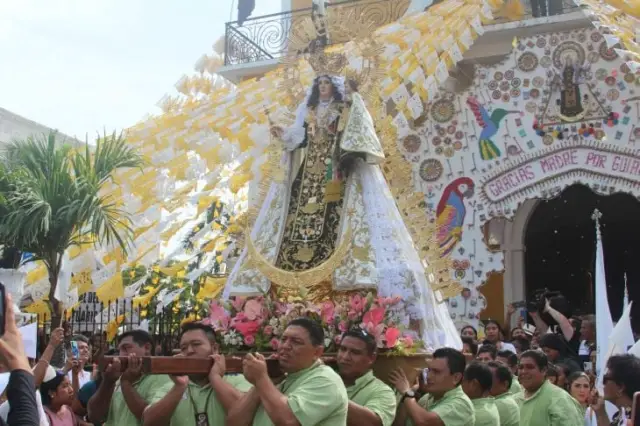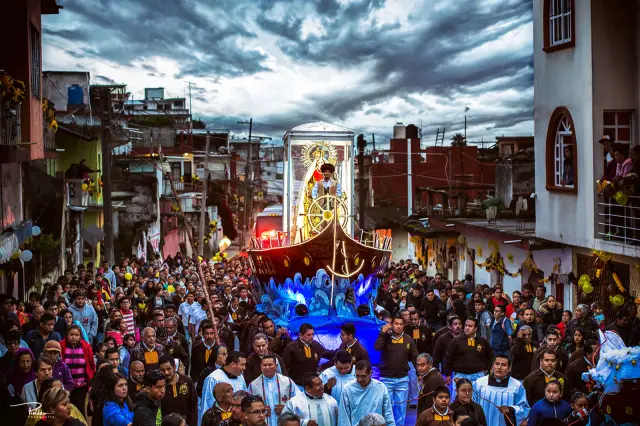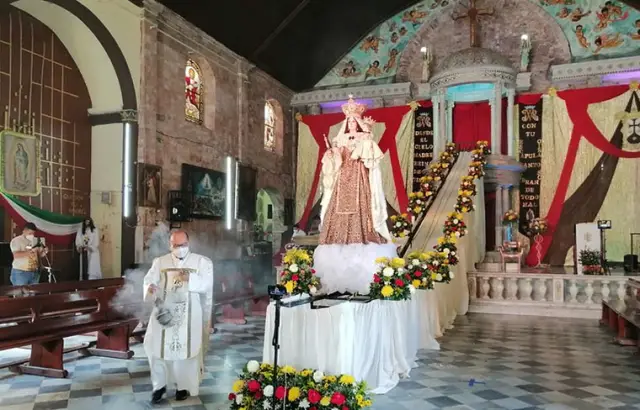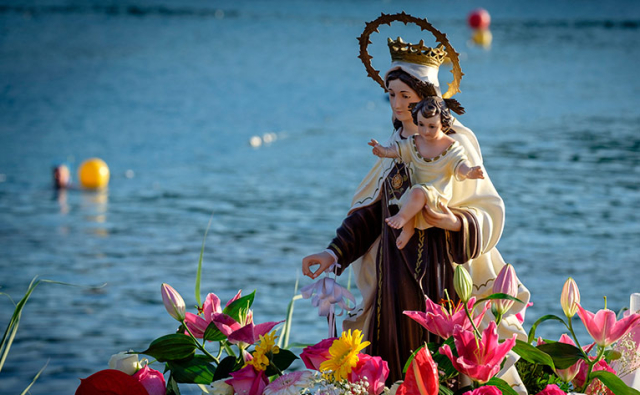The Feast of Our Lady of Mount Carmel , celebrated every July 16 , is a holiday deeply rooted in Mexican religious and cultural life. This Marian devotion, also known as Our Lady of Mount Carmel , is considered the patron saint of sailors, fishermen, truck drivers, and many Catholic communities. Her image represents protection, spiritual guidance, and hope in difficult times.
The image of the Virgin of Carmen is present in churches, home altars, and processions that fill Mexican towns and cities with flowers, candles, prayers, music, and expressions of popular faith. In this article, you will learn about the origins of this devotion, how it is celebrated in different regions of the country, and its spiritual, cultural, and social significance.
Origin and meaning of the Virgin of Carmen
Devotion to Our Lady of Mount Carmel has its roots in Israel, where a group of hermits settled in the 12th century to lead a contemplative life. These monks, known as Carmelites, chose the Virgin Mary as their patron saint under the title of "Our Lady of Mount Carmel." The Scapular of Our Lady of Mount Carmel, one of the most important symbols of this devotion, was traditionally given to Saint Simon Stock as a sign of protection and eternal salvation.
In Mexico, this devotion arrived during the colonial era through Carmelite missionaries and quickly gained the affection and faith of the people. Her image was adopted not only in churches but also in the heart of popular religiosity, especially in communities near the sea and regions where Mary is venerated as a protective mother.

How is the Day of the Virgin of Carmen celebrated in Mexico?
Religious and maritime processions
In several coastal communities such as Campeche, Veracruz, and Mazatlán , maritime processions have become a highly anticipated tradition. The boats, decorated with flowers, lights, religious images, and flags, carry the image of the Virgin of Carmen across the sea. During the journey, fishermen and families throw flowers into the water and pray for protection, good winds, and abundant fishing. It is a spectacle that combines faith, color, and emotion.
In the country's inland cities, processions are held by land. Groups of faithful walk through the streets with the image of the Virgin, singing songs, praying the rosary, and accompanied by musical bands and fireworks. These journeys usually culminate with a solemn mass and festivities in the main square.
Masses and novenas
Novenas , which consist of nine days of prayer and reflection, are an essential part of spiritual preparation for this feast. They are held in parishes, chapels, and even homes, where family and neighbors gather to pray together. These days of prayer allow us to renew our faith and ask for special favors from Our Lady of Mount Carmel.
On July 16 , a main Mass is celebrated in honor of the Virgin, which typically includes processions, special sermons, the blessing of the scapular, and acts of consecration. In many regions, this Mass is accompanied by mariachi or sacred music, making this event a moving and solemn gathering.
Altars and offerings
One of the most visible elements of the celebration is the decorated altars . These are set up in homes, streets, temples, and community centers and are elaborately crafted. Fresh flowers, candles, incense, religious images, fruit, bread, holy water, and the main symbol: the Scapular of Our Lady of Mount Carmel are used. Altar competitions are held in many localities, and prizes are awarded for creativity, devotion, and presentation.
These spaces are not only aesthetic, but also spiritual. They function as places of encounter, prayer, and gratitude to the Virgin for favors received. They are also opportunities to teach new generations about this tradition.

Popular celebrations in different regions
Mexico City
In traditional areas such as La Merced, Iztapalapa, Coyoacán, and San Ángel , the Virgin of Carmen is venerated with great fervor. Special masses , neighborhood processions, religious fairs, traditional dances, and the sale of scapulars, images, and souvenirs are held. The streets are decorated with confetti, flowers, and food stands, turning the festival into a true community celebration.
Campeche
The most notable celebration takes place in Ciudad del Carmen , where thousands of people participate in a maritime procession across the bay. It is one of the largest in the country. The image of the Virgin is carried by boat, escorted by fishing, tourist, and civilian vessels that throw flowers into the sea while horns are blown, prayers are said, and chants are sung. The celebration includes folk dances, fireworks, traditional food, and religious events.
Veracruz
In Tlacotalpan, Alvarado, and other riverside towns , the celebration of the Virgin of Carmen blends with local customs. Masses, river pilgrimages, and celebrations with jarocho harp music, folk dances, and traditional cuisine are held. It is an occasion that combines religiosity with Veracruz's cultural identity.
Importance of the Scapular of Our Lady of Mount Carmel
The scapular is one of the most important symbols of this devotion. It consists of two small pieces of cloth connected by cords that are worn around the neck. It represents the protection of the Virgin Mary , and those who wear it with faith trust in her intercession, especially at the moment of death. Wearing it also implies a commitment to live a consistent Christian life, with devotion and prayer.
On the Feast of Our Lady of Mount Carmel, it is common for the faithful to come and have their scapulars blessed, renew their spiritual promise, or receive this sign of faith for the first time. Some churches hold special ceremonies to impose the scapular on new devotees.
The Day of the Virgin of Carmen in art and culture
The influence of the Virgin of Carmen goes beyond the religious. Her image has been a source of inspiration for artists, musicians, poets, and writers . There are murals in her honor, popular songs that pay tribute to her, and legends that link her to miracles and prodigious events in different parts of Mexico. Many festivals include theatrical performances and cultural events that revive the history of her devotion.
This connection between faith and art strengthens a sense of community and conveys values through accessible and emotional forms.

How to participate in this festivity?
If you wish to join this Marian tradition, there are many ways to do so:
Visit a Carmelite parish or wherever the feast is celebrated, and participate in the Mass on July 16th.
Set up an altar at home decorated with white flowers, candles, an image of the Virgin Mary, and your scapular.
Pray the rosary or the scapular of Our Lady of Mount Carmel and meditate on its spiritual meaning.
Join a local procession and share the experience with your community.
Reflect and give thanks for the blessings you have received, keeping the tradition alive through faith and action.
Frequently Asked Questions (FAQ)
Why is the Day of the Virgin of Carmen celebrated on July 16?
Because it is the date on which, according to tradition, the Virgin appeared to Saint Simon Stock in 1251 and gave him the scapular as a symbol of protection.
What is the meaning of the Scapular of Our Lady of Mount Carmel?
It represents the promise of spiritual protection for those who wear it with faith. It is a symbol of consecration to the Virgin Mary and commitment to a Christian life.
Where does the most famous maritime procession in Mexico take place?
In Ciudad del Carmen, Campeche, where the celebration includes a solemn mass, a blessing of boats, a procession at sea, and cultural festivities.
Is it a holiday exclusive to coastal communities?
No. Although it is particularly important in maritime areas, it is also celebrated with great fervor in many cities and towns in the interior of the country.
What other cultural activities take place that day?
Fairs, traditional music, folk dances, religious handicrafts, and typical regional cuisine reinforce the local cultural identity.
Celebrate with faith and tradition
The Day of Our Lady of Mount Carmel is a living example of how faith, cultural identity, and tradition are intertwined in the daily lives of thousands of Mexicans. Participating in this celebration not only strengthens personal spirituality but also connects with a community that keeps its religious heritage alive. Whether in a maritime procession, a simple Mass, or in front of an altar at home, paying homage to Our Lady of Mount Carmel is an act of love, hope, culture, and faith. Keeping this tradition alive also means honoring our roots.
